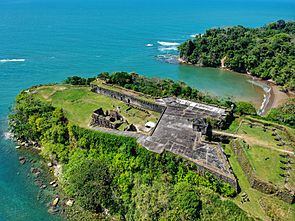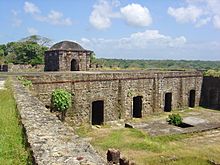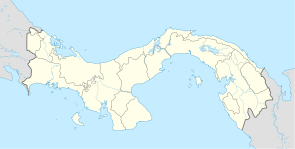Chagres and Fort San Lorenzo facts for kids
Quick facts for kids
Chagres
|
|
|---|---|
|
Depopulated village
|
|

The current ruins of Fort San Lorenzo date from the 1750s.
|
|

Map of Chagres and Fort San Lorenzo in about 1739
|
|
| Country | Panama |
| Province | Colón |
| District | Chagres |
| Established | 1680s |
| Depopulated | 1916 |
| Fort San Lorenzo | |
|---|---|
| Fuerte de San Lorenzo, Castillo de San Lorenzo de Chagres |
|
| Chagres, Panama | |

Fort San Lorenzo. 2009
|
|
| Site history | |
| Built | 1587 - 1750 |
| Built by | Spain |
Chagres (pronounced CHA-gres) was once a very important port on the Atlantic side of Panama. Today, it is an abandoned village located at the historic site of Fort San Lorenzo (in Spanish, Fuerte de San Lorenzo).
The ruins of the fort and the old village are about 8 miles (13 km) west of Colón. They sit on a high piece of land looking over where the Chagres River meets the sea.
Contents
History of Chagres and Fort San Lorenzo
Early Discoveries and Fort Building
In 1502, the famous explorer Christopher Columbus found the Chagres River during his fourth and last journey.
By 1534, after conquering Peru, Spain created a special route across Panama. This route, called the Camino Real de Cruces, was used during the rainy season. It involved mule trains and the Chagres River.
This path connected Panama City on the Pacific side to the mouth of the Chagres River. From there, treasures from Peru would be shipped to Spain from Atlantic ports like Nombre de Dios and later Portobelo.
Protecting Spanish Treasure from Pirates
Around 1560, pirates started attacking Panama's coast, trying to steal the valuable treasures. To protect the end of the Las Cruces Trail on the Atlantic side, Spain decided to build Fort San Lorenzo.
Work on the fort began in 1598, ordered by King Philip II of Spain. By 1601, the fort was a strong battery right at sea level. The plans for this huge fortress were made by an Italian engineer named Baptist Antonelli.
The castle of San Lorenzo was built on a high reef. This position gave it a great view and control over the entrance of the Chagres River.
Henry Morgan's Attack
In 1670, a famous buccaneer named Henry Morgan attacked Fort San Lorenzo. His forces completely destroyed the fort. The next year, Morgan used San Lorenzo as his base to invade Panama City.
In the 1680s, the Spanish built a new fort. This one was 80 feet (24 meters) above the water, on a cliff. A dry ditch and a drawbridge protected the fort from the land side. Around this time, the town of Chagres grew up under the fort's protection.
Changes in the 18th and 19th Centuries
In 1739 and 1740, British Admiral Edward Vernon attacked the Spanish forts at Portobelo and Chagres. After Portobelo's fort was destroyed, Spain stopped using it for trade. Instead, they made their forts at Chagres and Gatun stronger.
Because Portobelo declined, Chagres became the main Atlantic port in Panama. However, by the mid-1700s, Spain mostly stopped using the old trails across Panama. They preferred to sail all the way around South America, past Cape Horn. For over 100 years, Fort San Lorenzo was used as a prison.
The California Gold Rush and Chagres' Rebirth
In 1848, gold was found in California, leading to the California gold rush. Many people wanted to travel to California but didn't want to cross the "Great American Desert" or sail around Cape Horn.
They chose to follow the old Las Cruces Trail across Panama. Their journey started at "Yankee Town" or "Yanqui Chagres." This was a new, wild town that quickly grew on the bank opposite the original village and fort.
The Panama Railway and Chagres' Decline
Chagres' new importance didn't last long. By 1853, steamboats on the Chagres River cut the crossing time across Panama from several days to about twelve hours.
But in 1855, the Panama Railway was finished. This railway reduced the travel time across Panama to only about three hours. As a result, the railway's Atlantic end point, Colón, became Panama's main Atlantic port. Chagres then lost its importance.
20th Century: From Canal Zone to Protected Area
The building of the Panama Canal was finished in 1914. This project needed the huge Gatun Dam, about 7.2 miles (11.6 km) upriver from Chagres. The dam permanently blocked the river from inland trade.
Chagres was not part of the original Panama Canal Zone. But in 1916, the zone expanded to include the mouth of the Chagres River. The town of Chagres, which had about 96 houses and 400 to 500 people, was then "depopulated." Its residents were moved to Nuevo Chagres, about 8.2 miles (13.2 km) southwest along the coast.
Fort San Lorenzo has been a government-protected site since 1908. Today, the ruins of Fort San Lorenzo and the old Chagres village are part of the San Lorenzo Protected Area. This area covers about 30,000 acres (12,140 hectares) and was once part of the Canal Zone.
In 1980, UNESCO named Fort San Lorenzo a World Heritage Site. It shares this title with the fortified town of Portobelo, about 30 miles (48 km) to the northeast. Together, they are called "Fortifications on the Caribbean Side of Panama."
UNESCO describes these forts as "Magnificent examples of 17th- and 18th-century military architecture." They were part of the defense system built by the Spanish Crown to protect trade across the Atlantic Ocean.
Images for kids
In Fiction
Chagres is an important setting in The Adventures & Brave Deeds Of The Ship's Cat On The Spanish Maine: Together With The Most Lamentable Losse Of The Alcestis & Triumphant Firing Of The Port Of Chagres, a children's book by Richard Adams.
See also
 In Spanish: Fuerte de San Lorenzo para niños
In Spanish: Fuerte de San Lorenzo para niños
- Chagres District—a region in the Colón Province
- Chagres National Park—a park at the start of the Chagres River
- Chagres River—the river where Chagres and Fort San Lorenzo were built
- Fortifications on the Caribbean Side of Panama: Portobelo-San Lorenzo—more about the UNESCO World Heritage Site
- Nuevo Chagres—the main town of Chagres District today
- Portobelo—the other part of the UNESCO World Heritage Site
- San Lorenzo Protected Area—the area that includes Chagres and Fort San Lorenzo











